Holy Cow, Batman!
Once Russia annexed the Eastern Ukraine, any attacks on it would be de facto attacks on Russia. Reports are that a terrorist from American-controlled Syria drove a truck laden with explosives out of Russia and detonated upon the BIG bridge that connect the Crimea to Russia.
What is significant about this attack is the severity and planning. [1] It’s a major up-tick in hostilities. [2] It’s methodically planned, and involves American assets, not Ukrainian assets.
CRIMEA BRIDGE ATTACKED: Road collapse into water, Fuel Train ON FIRE!
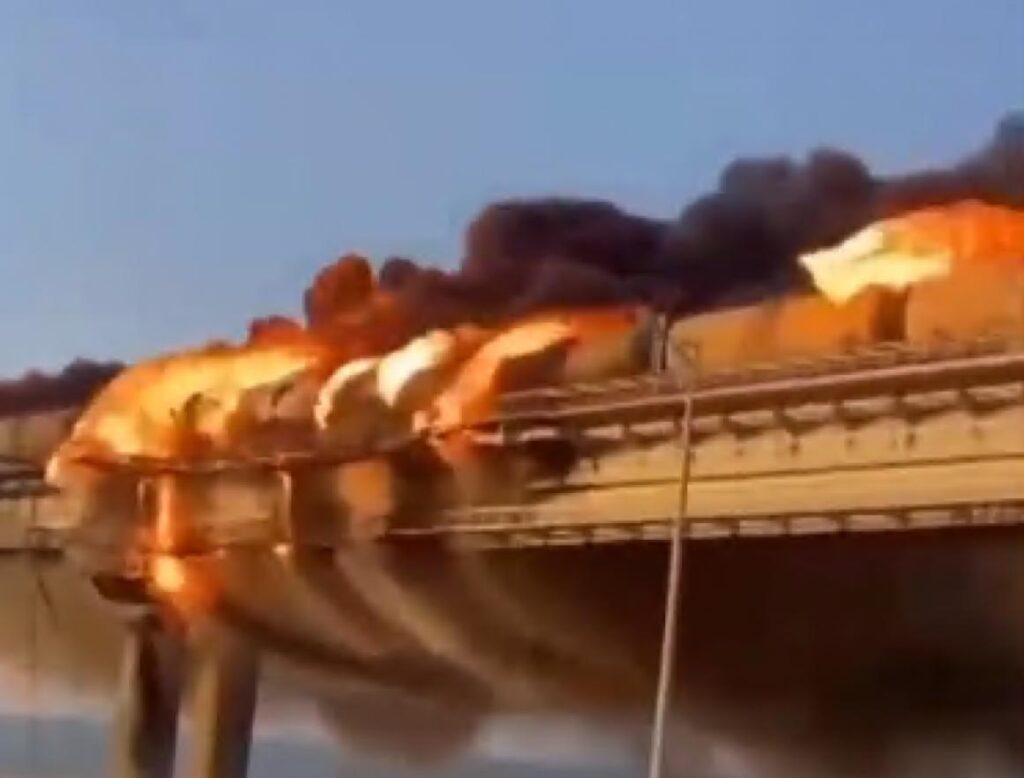
Multiple reports are coming in saying there is a train with fuel cars ON FIRE on the Crimea Bridge. One image, shown above, depicts multiple fuel tanker cars ablaze. The flames are impinging upon the structure of the bridge.
More info as I get it . . . Check back.
UPDATE 7:25 AM EDT —
The Crimea Bridge, connecting mainland Russia with Crimea, has been attacked by Ukraine!
The magnificent structure has three sections of roadway now collapsed into the sea, and a train on the adjacent railroad track portion of the bridge, is on fire.
Image from the passenger vehicle roadway of the bridge itself:
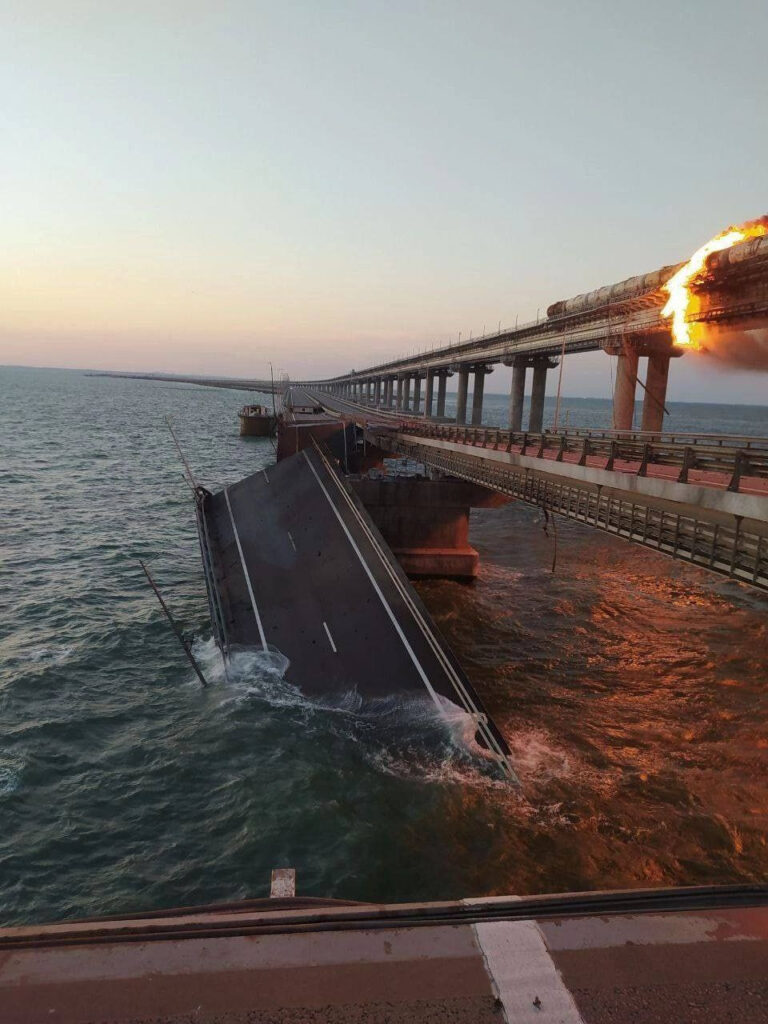
UKRAINE CLAIMS CREDIT FOR ATTACK
Ukraine admits responsibility for the terrorist attack on the Crimean bridge.
Zelensky’s office advisor Podolyak has admitted Ukraine’s responsibility for the terrorist attack on the Crimean bridge.
“Crimea, the bridge, the beginning. Everything illegal must be destroyed, everything stolen must be returned to Ukraine, everything occupied by Russia must be destroyed,” Podolyak said.
FEROCIOUS REACTION IN RUSSIA
“This is no longer just a challenge, this is a declaration of war without rules” – State Duma deputy Morozov about the terrorist attack on the Crimean bridge.
Russian Senator Alexander Bashkin says Moscow will answer Crimean Bridge attack with a “possibly asymmetric response.”
Deputy Speaker of the State Duma: The terrorist act that targeted the Crimean bridge was a declaration of war against Russia.
POLICE INVESTIGATION SO FAR . . .
Police say a Suicide bomber was driving this truck that exploded on the Crimean bridge, presumably, coming from Krasnodar, stuffed with explosives.
He passed through the traffic Police post and detonated on the bridge. The mileage of the truck is 870,000 km.
Truck that exploded on Crimean bridge was not taken for X-ray, and its driver had all the documents in order, according to Mash, citing traffic police officers. He entered the bridge from Russian mainland. There is no x-ray gate to detect explosives as it’s on Crimean site.
Sources report that the driver of the truck has been identified. According to our sources, he could be Biji al-Kamurji, a native of Syria.
UPDATE 9:27 AM EDT —
According to preliminary data, three people were killed as a result of an explosion on the Crimean Bridge, the Investigative Committee of the Russian Federation reports. Passengers of a car driving next to an exploding truck were killed, the bodies of a man and a woman were lifted out of the water.
According to the investigation, the owner of the truck blown up on the Crimean Bridge is a resident of the Krasnodar Territory.
Investigative actions have been launched at his place of residence
At this hour, the rail car fires on the railroad track span of the bridge, are being doused by helicopters dumping water from fire-fighting buckets.
Ukraine SitRep – Recent Incidents Of Concern For All Sides
Yesterday saw two significant developments or incidents with regard to the conflict in Ukraine.
The Kerch bridges which connect Crimea with Russia, one for cars and one for trains, were sabotaged. At least one of the two road spans has fallen down while tanker rail cars on the parallel train bridge caught fire.
CCTV footage shows that a truck exploded while passing the bridge. Here is a video of the damage. One of the two road spans seems to be intact.
As the pillars of the bridge seem unaffected a repair of the broken road span is possible but will take some time. The more sturdy railway bridge may have some superficial fire damage but Russia is one of the few countries that has designated railroad troops specialized in and equipped for railway repairs. The railway traffic is likely to be back within a few day or weeks.
This is a severe handicap for Russian logistics to the frontlines in south Ukraine but not a catastrophe as alternative rail and road routes, as well as ferries, are available. Military logistics is designed to work even under significant constrains. It will find ways to work around the problem.
Adam Kinzinger🇺🇦🇺🇸✌️@AdamKinzinger – 16:26 UTC · Oct 7, 2022Evidently the Starlink system is down over the front lines of Ukraine. @elonmusk should make a statement about this, or, this should be investigated. This is a national security issue.
Tore @potifar66 – 21:55 UTC · Oct 7, 2022Some of the outages led to a “catastrophic” loss of communication in recent weeks, said one senior Ukrainian government official with direct knowledge of the issue.
ft.com: Ukrainian forces report Starlink outages during push against Russia
Some of Elon Musk’s SpaceX devices stopped working when Ukrainian soldiers liberated territory, Kyiv officials say
The Russian army is leading globally in its abilities to wage electronic warfare. It can disable ground based radio traffic on any frequency. It has now found ways to also disable ground to satellite connections as used by the Starlink constellation.
At the beginning of the war the Ukrainian military was supplied with thousands of Starlink ground terminals that can connect to the swarms of small Starlink satellites, which were financed by the Pentagon, but managed by Elon Musk’s companies.
They allowed for communication between Ukrainian ground units as well as for general command and control of larger operations. Without Starlink the Ukrainian command will depend on cable based field telephone, runners and couriers. All of which are extremely vulnerable in an artillery rich environment.
Since 2001 Russia developed the Tirada 2 electromagnetic system which can disable ground to satellite traffic in specific areas.
Russian military in the near future can get into service systems that can disable enemy communication satellites, an informed Interfax interlocutor in the military-industrial complex said 05 January 2018. “One of the projects is Tirada 2. Development work was started back in 2001,” he said. According to him, this complex will be able to disable communication satellites from the ground. “He acts by electronic suppression. This is a multi-million dollar project,” he said. The fact that the Russian Federation is working on the creation of weapons to suppress satellites was announced on November 30 last year by Oleg Achasov, deputy head of the Federal State Budgetary Institution “46 Central Scientific Research Institute”.
…
In November 2018, the FSB called the “threat to national security” a project to cover the globe with high-speed satellite Internet.
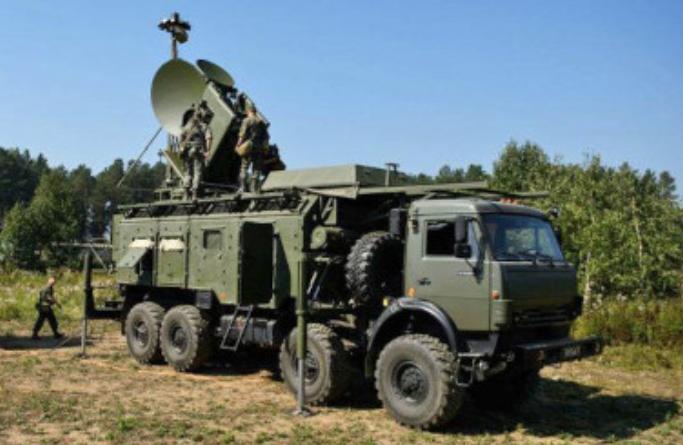
biggerIn 2019 an OSCE observer drone took pictures of a Tirada complex in the Donbas region.
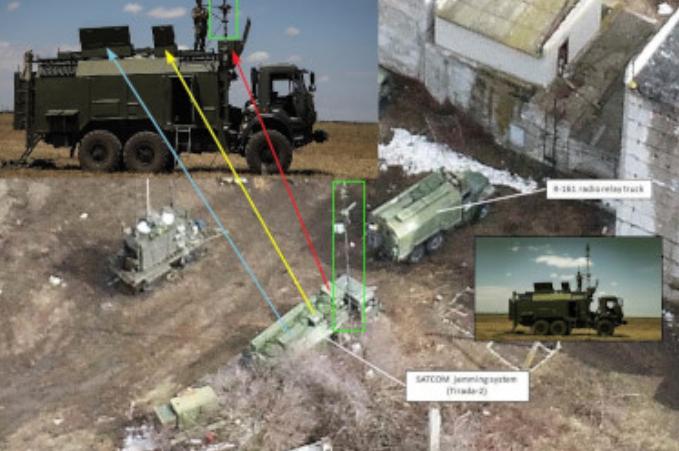
biggerThe disablement of the Starlink communication traffic was only a question of time.
The traffic had to be analyzed to identify the frequencies and algorithms used by the transmitter and receiver. Software had to be written to implement a matching radio jamming pattern. The hardware of the Tirada system was likely already sufficient to emit the appropriate patterns on the identified frequencies.
As this system has now been proven to be effective in the field it will likely be made available on a wider scale.
Russian electronic warfare equipment can already disable all ground radio traffic in specific areas. Soon all frontline communications of the Ukrainian forces will be disabled.
This is catastrophic for Ukrainian operations.
Forward observers will no longer be able to correct artillery missions. Platoons and companies at the front will have no way to call for support. Higher command will have no way to coordinate larger operations in real time.
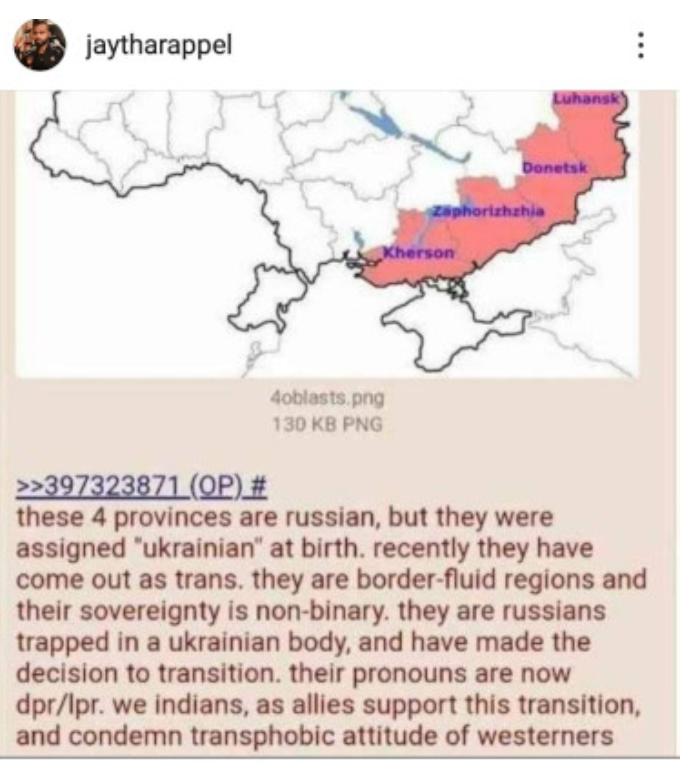
“These four provinces are Russian, but they were assigned ‘Ukrainian’ at birth. Recently the have come out as trans. They are border-fluid regions and their sovereignty is non-binary. They are Russians trapped in a ‘Ukrainian’ body, and have made their decision to transition. Their pronouns are now DPR/LPR. We Indians as allies support this transition and condemn the transphobic attitudes of westerners.”
Something tells me that soon more ‘Ukrainian’ oblasts will come out and recognize their real being.
Today there was a sortie of foreign mercenaries in the Zaporozhye direction, which included, among other things, American special forces soldiers. They were so self-confident that they decided to carry out reconnaissance in battle with this stellar squadron. However, they did not take into account the presence of our units in this zone, which are able to maintain secrecy on the air, and suffered losses. However, some of these bastards still managed to escape. The presented photos are screenshots of the video from the go-pro camera of one of the dead mercenaries, who literally lost his head. I’ll probably post the video tomorrow.

biggerI have no way to verify those claims but a recent Intercept report stated that there are significant U.S. forces on the ground in Ukraine:
One U.S. official insisted that the CIA only conducted a partial withdrawal of its assets when the war began, and that the agency “never completely left.”Yet clandestine American operations inside Ukraine are now far more extensive than they were early in the war, when U.S. intelligence officials were fearful that Russia would steamroll over the Ukrainian army. There is a much larger presence of both CIA and U.S. special operations personnel and resources in Ukraine than there were at the time of the Russian invasion in February, several current and former intelligence officials told The Intercept.
Secret U.S. operations inside Ukraine are being conducted under a presidential covert action finding, current and former officials said. The finding indicates that the president has quietly notified certain congressional leaders about the administration’s decision to conduct a broad program of clandestine operations inside the country.
These will not be the only U.S. casualties in Ukraine. When more such reports come out the issue is likely to explode in Biden’s face.
Posted by b on October 8, 2022 at 7:58 UTC | Permalink
An interesting comment
I rather doubt it was a suicide bomb. The driver may have died, but if he did, it is unlikely to have been voluntary. If I were a jihadi, I’d have trouble believing that dying on behalf of hyper-christian UkroNazis would get me welcomed by the 72 virgins in Paradise, because that is what they believe. It’s completely the wrong doctrine. doesn’t work at all. There may be some jihadis fighting for Ukraine, but that would be as mercenaries, to make a living, not a dying.
Posted by: laguerre | Oct 8 2022 10:15 utc | 63
And a follow up comment…
Directions
- In a bowl, whisk the egg and milk.
- Add bread crumbs, 1 tablespoon gravy mix and onion.
- Crumble beef over mixture and mix well.
- Shape into two patties, about 3/4 inches thick.
- Broil 3-4 inches from the heat for 6-7 minutes on each side or until meat is no longer pink and a meat thermometer reads 160°.
- Place the remaining gravy mix in a small saucepan; stir in the water and mustard. Bring to a boil; cook and stir until thickened. Serve over patties.
Is China the next United States ?
No. The United States is the World Police turning into a Bouncer for Hire. China’s aspiration is to be the Cook.
The United States was catapulted into Superpower during WWII, where its entire industrial base was turned into arms manufacturing. It could have disarmed after WWII, but one thing led to another, that was never done, and so here we are, with Mr. Trump selling protection and blackmailing other countries for protection money.
China is concerned about getting enough to “eat”, and she has figured out that the cook never starves, no matter who else might be starving. So she’s been going around cooking up iPhones, trains, pots and pans, and bridges for other people, and, well, making a tidy sum out of it, and feeding her own family with cents on the dollar (‘cause she makes the stuff herself, so no restaurant mark-up).
So what happened next, was that Mr. Obama calling China “a free rider for thirty years”, because she doesn’t do anything for “global security”. But I think Mr. Obama failed to appreciate the fact that a cook can not look like a bouncer and going around cracking other people’s heads – who in the world will order dinner from a cook that looks like a bouncer? Basically if you want to be the cook for the world, you have to be (or at least appear to be) AMIABLE to everybody! China is friendly with both the US and Russia, both Iran and Saudi, both Israel and Palestine, all four different governments in Yemen, etc.
But if you are a bouncer, well, you’ve got to take sides (“Good vs. Evil”), show your muscle, and beat up somebody occasionally. And you need enemies, otherwise, how do you get customers coming to you looking for protection? Right? But if you are going to fight for the Saudis, the Iranians are probably not going to be buying iPhones and automobiles from you. C’est la vie.
So no, China is not the next United States, because a Cook doesn’t need any Enemies, only customers.

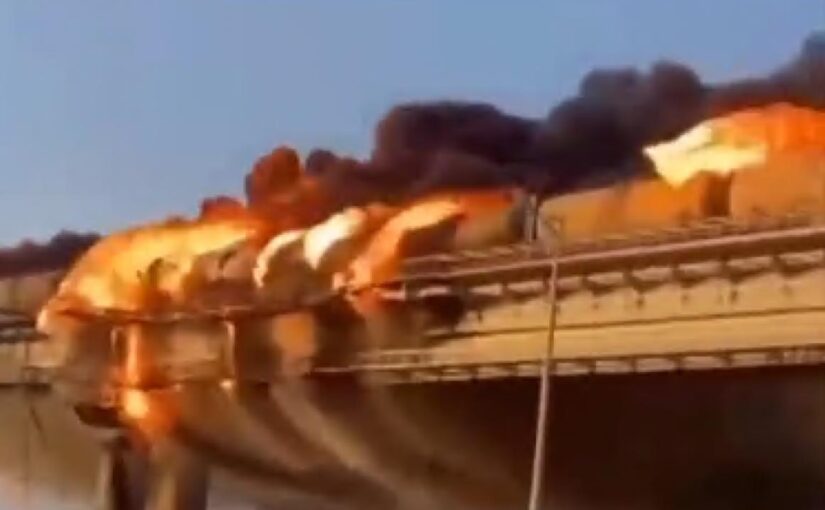


… Doesn’t rule out an involuntary sacrifice by an unknowing trucker, though
Posted by: Objective Observer | Oct 8 2022 10:24 utc | 70
Now, don’t have a cow
Spanky and Our Gang Like To Get To Know You
Why do people accept China’s statement that China does not mess with other countries’ sovereignty? What about China’s 1979 invasion of Vietnam, and the threats to nuke Okinawa, Australia and the UK?
That war lasted 1 month. China went in, went out, done. They did not occupy, suppress, overthrow, or anything.
I mean, OK, we can give you that. A single invasion lasting one month, whereby China then just left.
As for threats, please… everyone threatens everyone else. It is whether you are likely to do it. China has a no-first strike policy and their historical pattern says they aren’t generally aggressive.
When China threatens consequences, you all laugh out loud because you know they won’t do it.
When the West threatens, it may very well happen. Nordstream didn’t just blow up by itself. Biden threatened it, and it happened.
When people say “The US would go broke with universal healthcare,” who exactly are they saying would go broke?
Harvard Business College has done multiple studies comparing universal health care with the current for profit insurance in the U.S.
We pay four times what other countries who have universal health care pay in taxes, with less benefits.
The money goes into a pot, much like a social security fund. From that pot, bills are paid.
It sounds easy enough, right? The problem is that some people can’t conceive something as simple as tax money in a fund to pay for medical bills would actually work. The medical bills are paid; they aren’t fought. No preapproval crap. Get sick. Get treated…complain about the $15 for parking.
The argument I hear over and over is this: “I don’t want to pay for Wanda down the street because she is black/brown/gay/has pink hair and I want better insurance than she has.”
The simple fact is that you do pay for Wanda’s medical insurance. Insurance companies pool the money into a fund. Insurance companies do all they can to deny a claim because that’s how they make money. The ACA put an end to “pre-existing conditions” but it still happens. If it happens and you are seriously ill, you are f***ed.
They contract with providers (hospitals, doctors, and clinics) and then agree to pay “allowable charges.” The allowable charges are, for example: the x-ray charge is $35 but we will only pay $20 and you have to write off the rest. Sometimes the insured has to pay a co-pay.
One man on Quora stated in his post he pays about $148 a month for health insurance. I paid $225 a WEEK for health insurance.
Legislators who are opposed to universal health care are bought and paid for by the insurance industry. You can call them lobbyists, but I call it bribery.
Why is Quora full of Westerners who praise China?
It’s very simple. These Westerners:
In other words, they know the real China and they appreciate the wonderful qualities of that nation.
They recognize and admire China’s amazing achievements over the past several decades.
One Toke Over The Line – Lawrence Welk – WTF! (1971)
What’s trending on MM right now…
Dear British people who’ve lived in the US and have experienced the wonder that is the American donut: why aren’t there more donut shops in the UK?
A few years ago, there was a court case in Ireland involving American sandwich chain Subway. It was over a question of sales tax law. The substance of the judgement was that the sugar content of Subway bread was so high that it legally qualified as cake under Irish law, and was therefore subject to a higher rate of tax.
I mention this to illustrate just how pervasive in the US the practise of adding sugar to processed food is. A lot of sugar. Americans have become accustomed to this, over the course of decades. While this does happen in the UK as well, it is nowhere near as pervasive, so British people have not built up as high a tolerance for sugar, despite the fact that we are regarded as having a sweet tooth by European standards.
US donuts are, in my opinion, unpleasantly sweet and stodgy. I do not find them particularly wonderful. Also, we have our own array of unhealthy baked goods, largely ripped off from the French. Give me a chocolate eclair over a US donut any day of the week.
How the US is unleashing a recession on the world
From HERE
When elephants fight, the grass gets trampled. The African proverb seems particularly apposite right now as three global elephants drive the world towards recession.
China continues to fight Covid-19 outbreaks by sporadically locking down millions of its people, thereby cutting the output of the world’s factories, exacerbating supply chain issues and fuelling inflation, long after other governments have told their populations to get vaccinated and get back to work.
Russia continues to fight Ukraine, and by extension Europe and the rest of world, using oil, gas and grain as weapons, thereby causing global energy and food crises, and also fuelling inflation.
And the biggest elephant of all, the United States of America, by aggressively lifting interest rates in the hope of squashing its domestic inflation problem has instead succeeded in exporting it to the world.
That is a big problem, particularly for those of lesser economic means, including many Australians. They are the grass that gets trampled.
Sharp rises in interest rates, intended as a cure for inflation, could prove to be the wrong medicine and worse than the disease, as the World Bank warned in the middle of last month. Central banks around the world, it said, were “raising interest rates this year with a degree of synchronicity not seen over the past five decades – a trend that is likely to continue well into next year”.
World Bank Group president David Malpass warned that rate hikes of sufficient magnitude to rein in inflation could themselves push the world into recession.
“To achieve low inflation rates, currency stability and faster growth, policymakers could shift their focus from reducing consumption to boosting production,” he said. “Global growth is slowing sharply, with further slowing likely as more countries fall into recession. My deep concern is that these trends will persist, with long-lasting consequences that are devastating for people in emerging market and developing economies.”
A week later, on September 22, the US central bank, the Federal Reserve, or Fed, raised its benchmark interest rate by a whopping 0.75 percentage points, for the third time in a row.
From a strictly American viewpoint there are good reasons why the Fed has been jacking up interest rates.
As recently as May 2020, at the height of the Covid pandemic, US inflation was just 0.1 per cent, well below the Fed’s target of 2 per cent a year. The fear then was that the economy was stalling. Like many others, the US government was desperately trying to stimulate the economy. The Fed was holding interest rates effectively at zero.
But as the pandemic subsided, the US economy roared back. As in Australia, unemployment fell to very low levels, about 3.5 per cent. But unlike Australia, wages growth shot up as a result – to nearly 7 per cent by June. That added fuel to inflation, which reached 9.1 per cent that month.
Inflation has since slowed to just above 8 per cent, but wage pressures continue. And the Fed chair, Jerome Powell, insists he will not stop raising rates “until the job is done” to curb inflation.
What makes this a global problem is that the US dollar is essentially the world currency – the “reserve currency”. International trade is overwhelmingly conducted in American dollars; financial institutions and corporations transact their business in them, contracts for goods and services are denominated in them.
And when the US hikes its interest rates, the value of the dollar increases relative to that of other currencies. Right now, the greenback is stronger than it has been in decades.
This, in turn, has put pressure on other central banks to raise their rates, lest their currencies fall, which in turn makes imports more expensive and fuels their inflation rates. It’s a vicious, global cycle.
As journalist for The New York Times Patricia Cohen put it last Friday, the Fed’s dramatic rate hikes have caused “economic turmoil in both rich and poor nations”.
Among the consequences she ticked off:
“In Nigeria and Somalia, where the risk of starvation already lurks, the strong dollar is pushing up the price of imported food, fuel and medicine. The strong dollar is nudging debt-ridden Argentina, Egypt and Kenya closer to default and threatening to discourage foreign investment in emerging markets like India and South Korea.
“Last week, Argentina, the Philippines, Brazil, Indonesia, South Africa, the United Arab Emirates, Sweden, Switzerland, Saudi Arabia, Britain and Norway raised interest rates.”
Meanwhile, the cost of imports to US consumers has fallen sharply. Cohen cited a couple of quirky examples of how the stronger dollar was calming US inflation: “Last year, a £12 tin of tea from Britain cost $16.44, and today it costs $13.03. A €50 box of Belgian chocolates has gone from $58.50 to $48.32.”
But it’s not just tea and chockies. The strong dollar makes all sorts of things cheaper for Americans. There have even been suggestions that the falling price of petrol in America has been a major factor in the rebounding political popularity of President Joe Biden and Democratic congressional candidates ahead of next month’s mid-term elections.
It’s probably no comfort to Australians – who are paying through the nose for rental accommodation if they can even find any, or new homeowners whose mortgages have lately become less affordable and whose biggest asset is now worth less than they paid – but their suffering is at least helping the US Democratic Party get re-elected.
Almost all of us are suffering financially to some extent. Even before the spike in inflation, average wages were barely keeping up with prices for a decade. Now they are going rapidly backwards. And the putative cure for high inflation – higher interest rates – has seen the price of houses fall, for those of us lucky enough to own one.
The RBA has been hiking strenuously to keep up with its global counterparts. It’s already raised interest rates 2.5 percentage points since May, taking the cash rate from an all-time low to 2.6 per cent. The pace appears to have slowed, with a quarter-point increase this week following four consecutive half-point moves, but governor Philip Lowe said further rate increases were “likely”. The smaller than expected increase this month allowed time to assess “the outlook for inflation and economic growth in Australia”.
We are faring better than many other countries – the Australian dollar has fallen only about 11 per cent against the US currency in the past year, far less than some. Inflation has been much lower, the economy still is growing solidly and unemployment is near a 50-year low.
But the suffering from inflation and interest rate rises has been very unevenly distributed.
Moreover, as a result of the long period of low rates up until March, and the money handed out by the government during the Covid period, many households have built up what Lowe called “large financial buffers”.
Not all people are in the same cashed-up boat, however.
“For new borrowers, it’s going to be really tight, because people have borrowed four, five, six times their annual income. A lot of them are going to really feel the squeeze,” says Brendan Coates, economic policy program director with the Grattan Institute.
It will be felt more intensely, too, by those who bought a property to live in, compared with those who bought one as an investment, because the latter can take advantage of negative gearing.
“Those that have mortgage deductibility … depending on what their marginal tax rate is, could wipe off 30 to 47 per cent of the cost of the rate rises by claiming them as deductions against their income,” says Coates.
The other thing property investors can do, of course, is whack up rents.
And they have.
“Capital city average level rents are up 20 per cent, just over the last 12 months,” says Louis Christopher, managing director of property market analysis firm SQM Research, which surveys advertised rent prices every week.
In 2021, he says, housing prices were rising faster than rents, but even since the housing market downturn, rents – and yields to landlords – have continued to rise, interest rate increases notwithstanding.
The standard tenancy agreement, he notes, runs for 12 months, and then month-to-month after that.
“So if you’re on a 12-month lease, and then you’re looking to go back into the market, you can expect to pay essentially 20 per cent more on a like-for-like property,” he says.
That’s if you can find one. The current vacancy rate is at a record low of 0.9 per cent nationally, he says, and worse in some areas.
The tightening of supply might seem counterintuitive, given Australia’s closed borders during Covid. A partial explanation lies in the fact that people working from home wanted more space. The result was fewer people per home.
Another factor is the rapid growth of short-term accommodation, provided by the likes of Airbnb.
“That’s a biggie,” says Christopher. “The market share of short-term leasing has rapidly expanded compared to the long-term leasing market, even though the absolute numbers are broadly the same.
“There are actually more Airbnb properties on the market in Melbourne and Brisbane now than long-term leases.”
The major driver, he says, “is landlords feel more in control of their property in the short-term leasing market”. For renters, he says, times are “grim, absolutely”.
We can’t blame “big business” for this predatory behaviour – at least not directly. According to Grattan figures, about 85 per cent of rental properties in Australia are owned by landlords who have three or fewer properties.
What we can point to is a chain of causation: the pandemic that caused global supply chain chaos, the Ukraine war that caused the energy crisis, the energy companies that profiteered, the central banks that jacked up interest rates, on down to the mum and dad investors who seek to offset their declining real wages and increased borrowing costs by exploiting those in need of a place to live.
Some blame, too, can be attached to government. Before the 2019 election, Labor promised to reform negative gearing and capital gains taxes. Had it won, the rental crisis might not be so dire.
Instead, Australia elected the Morrison government, whose answer to the growing housing crisis was, in the words of Kate Colvin, to give would-be homeowners “a bit of extra money to compete against everyone else”, which only served to drive up prices.
“It was policy vandalism,” says Colvin, who is the spokesperson for Everybody’s Home, a coalition of housing, homelessness and welfare organisations set up in 2018 to push for change to make housing more affordable.
Australia’s housing market is “pretty fundamentally broken”, she says.
“Twenty years ago, the private market basically worked to deliver housing product to low-income renters, particularly in regional areas. Twenty years ago, 50 per cent of even one-bedroom places were affordable to someone on [the equivalent of a] JobSeeker payment. Now no rentals are affordable to someone on JobSeeker,” she says.
And the recent decline in housing prices has done nothing to make things easier for either renters or new buyers.
“So the cost of houses and units has decreased, but only because interest rates have increased, meaning housing was actually no more affordable.”
What is desperately needed is more public and affordable housing.
There are some positive signs, but only small ones, Colvin says. The new Albanese government has committed to building 30,000 social and affordable properties over five years. A number of the states also have made commitments to increase supply, most notably Victoria, with $5.3 billion over four years to build 12,000 social and affordable rentals.
“But it is still the lowest proportion of social housing of any state, and they really need to keep investing beyond that or investment will sort of run out in 2024.”
And the commitments to increased supply “following decades of underinvestment” are nowhere close to meeting demand.
“The current shortfall is more than 430,000 properties for social housing, and if you add in affordable, it’s more than 600,000. So it’s huge.”
One encouraging development, says Colvin, is that after five years in which the previous government did not even bother to sit down with the states to discuss the crisis, the new government has had “federal and state housing ministers sitting around the table together, discussing these challenges”.
It is a social crisis for those involved, of course, but also an economic crisis for the nation, Colvin says.
“It’s a social crisis because you can’t get on with the daily business of ordinary life and going to work and stuff when you’re living in a tent. But it’s also an economic crisis, because every community needs low-paid workers to function.
“You need supermarket workers, you need disability support workers, aged-care workers, childcare workers, all of those human services, and communities can’t recruit those kinds of workers because they can’t afford to live locally.”
The human costs of unsustainable housing costs are many and varied, says Kasy Chambers, executive director of Anglicare Australia.
“Rent is not elastic,” she says. “You can’t just pay half the rent. You have to cut other things that are.”
So people don’t go to the dentist or doctor, or don’t fill prescriptions for medicines.
“Those are some of the first [expenditures that] tend to go. Car insurance, that kind of stuff. We’re talking to people who are doing things like turning off [their] hot water to save money, going to bed very, very early. Cold is a big issue.”
And that’s for people who have somewhere to live – Chambers says Anglicare is seeing “more and more people who just can’t afford rent, couch surfing with friends, moving into tents, cars, that kind of thing. And it’s a very difficult road to come back from.”
Increasingly, these people also go hungry or rely on food banks for meals.
Anglicare has just completed a survey of its national network of emergency care providers, which help out with things such as food hampers or vouchers, transport or medical costs, utility payments, rent and, in some cases, employment subsidies. Demand was sharply up everywhere since the beginning of this year, in some cases by 50 per cent or more.
The new cohort of people needing help includes home owners and the “working poor” who are struggling to pay for food and utilities, as well as more single parents and people on disability support and aged pensions.
These are not the sort of people with whom central bankers, or other world leaders, or the heads of multinational corporations, or even mum and dad property investors, usually consort. They are the grass that gets trampled as the globe’s biggest battles – to contain a virus, to crush an independent country, to save a US president – rage on.
This article was first published in the print edition of The Saturday Paper on October 8, 2022 as “How the US is unleashing a recession on the world”.
Blues Brothers – Mall Car Chase
China’s factory activity unexpectedly expanded in September.
An official survey showed on Friday, even as authorities imposed strict COVID-19 curbs in big cities and export growth softened.
BEIJING, Sept 30 (Reuters) – China’s factory activity unexpectedly expanded in September, an official survey showed on Friday, even as authorities imposed strict COVID-19 curbs in big cities and export growth softened.
It returned to growth after contracting for two consecutive months.
The official manufacturing Purchasing Managers’ Index (PMI) edged up to 50.1 in September, from 49.4 in August, data from the National Bureau of Statistics (NBS) showed on Friday.
The 50-point mark separates contraction from growth on a monthly basis.
Economists in a Reuters poll had expected the PMI to come in at 49.6.
From HERE
The Hangover Part II (2011) – Wake Up Scene
Cow puns
Think you’ve herd them all? Cows are pretty funny and it would be a total shame if we didn’t milk them for all they’re worth. There are just too many play-on-words not to have a bunch of cow puns at your disposal at the next event—hopefully on a farm. At the least, you’ll have a new-found appreciation for these incredible animals.
1. Watch out, you don’t want to butcher any of these jokes.
2. The steaks are high.
3. I have some real beef with that guy.
4. I got the mooves like Jagger.
5. Make sure you show up on time, otherwise Bessie will have a cow.
6. Milk it for all it’s worth.
7. I am not amoosed.
8. And then I told my therapist that I feel seen, but not herd…
9. I am udderly in love with you!
10. Not as mooch as I love you.
11. I always found cowculus to be the most interesting subject.
12. The cow was so excited for the day ahead that he was over the moon.
13. An udder day, an udder dollar.
14. Seize the moo-ment!
15. Holy cow!
16. Steer clear! Cows coming through!
17. Move! Get out of the hay!
18. If you feel like you’ve herd all these cow puns before, you probably have deja-moo.
19. Cow bells make such beautiful moosic.
20. A cow in an earthquake is called a milkshake.
Tony Kills Matt Bevilaqua – The Sopranos HD
Cow jokes for kids
Cows are pretty legen-dairy so of course, there’s an abundance of clever jokes that will make your child giggle about how funny these farm animals really are. You may even find yourself suppressing a laugh at these cow jokes for kids. Get your children to appreciate where their ice cream really comes from by making them love cows just as much as we do.
21. What did the mama cow say to the baby cow?
It’s pasture bedtime!
22. Why did the two cows not like each other?
They had beef.
23. How do you count cows?
With a cowculator!
24. What happens when you try talking to a cow?
Everything just goes in one ear and out the udder.
25. Where do cows eat lunch?
In the calfeteria.
26. What did one dairy cow say to the other?
Got milk?
27. What do you call a sad cow?
Moo-dy.
28. What do you call a cow that can’t make milk?
A milk dud.
29. How do you make a cow be quiet?
Press the moo-te button.
30. What do cows read in the morning?
The moos-paper!
31. How did the farmer find the missing cow?
He tractor down.
32. How do you know which cow is the best dancer?
See which one has the best moo-ves.
33. What does the cow band play?
Moo-sic!
34. Why did the cow cross the road?
To get to the udder side!
35. What does the farmer talk about while milking a cow?
Udder nonsense.
36. What do you call a cow jumping on a trampoline?
A milkshake.
37. Where do cows get all their medicine?
The farmacy!
38. How did the cow get to the moon?
It went to udder space.
39. Why did the cow jump over the moon?
To get to the Milky Way.
40. What do you call it when one cow spies on another cow?
A steak-out.
41. Why do cows have hooves instead of feet?
Because they lactose.
42. What do you get if you cross a cow and rooster?
Roost beef.
43. What kind of shows do cows like best?
Moosicals.
44. What happens when a cow laughs?
Milk comes out of its nose.
45. What has the lone cow been up to lately?
Nobody’s herd…
46. How do dairy farmers do their taxes?
They go to an accountant.
LUCY Clip – “Crossing the Spacetime Continuum” (2014)
https://youtu.be/iJeOv5BVVPs
Cow knock knock jokes
Get ready to be amoosed. Everyone loves a playful knock-knock joke, but these cow knock-knock jokes are udderly hysterical. Who knows, they may even inspire some of your own to get everybody laughing. But we promise if you start with these, you’ll definitely get a few chuckles.
47. Knock knock.
Who’s there?
Cows go.
Cows go who?
No, silly, cows go moo!
48. Knock knock.
Who’s there?
Cow.
Cow who?
Cow-a-bunga, dude!
49. Knock knock.
Who’s there?
Cow.
Cow who?
Cow much longer will you put up with all this knocking?
50. Knock knock.
Who’s there?
Interrupting cow.
Interrupting cow wh-
Pee-wee’s Breakfast (1985) HD
The Best Chili You Will Ever Taste
“This is the best chili recipe I have ever tried. I’m not sure where the recipe originated, but it is amazing! Sometimes, I don’t bother adding all four cans of the kidney beans and it still turns out wonderful. Once anyone tastes this chili, they will be begging for the recipe!! Enjoy!”
Ingredients
Directions
Why do some mainland Chinese see the Western democratic system as a joke these days?
Yes, even though I am in Hong Kong (though I am now hiding in mainland China due to the epidemic).
Before the epidemic came, I still had a degree of trust in the European and American governments, for example, when the epidemic first hit, many Chinese people ran to the US. I even had the same thought. People thought that the US was technologically advanced in terms of medical care and that, as a modern government, it would handle the situation better than China.
As a result, we all saw what happened afterwards. The US was a mess.
This made me start to reflect on whether the American system was really that good.
It was a good hand, but it turned out to be a bad one.
And look at all the other situations in the United States, from the simplest problem of law and order to the more complex problem of the poor. The situation in the US makes me think that this government never does anything practical.
China’s various resources, the problems it faces, are actually far more difficult than the US. But China has still managed to control the epidemic and ensure high economic growth. The World Bank expects China’s economy to grow by 8.5% this year, a rate that in a normal year would be equivalent to almost 10%-13% growth, which is incredible for an economy that already has a total economy of US$16 trillion, and no such achievement in the history of human development.
Before the epidemic, the Kennedy School of Politics at Harvard University reported that the Chinese government’s approval rate was already 95%. After two years of dealing with the epidemic, I personally estimate that the Chinese government’s approval rate may have reached 99%, which is also an incredible high in human history.
I am not a member of the CCP, but comparing the current situation in China and the West, I definitely support the Chinese system.
Would I rather experience being held down by the police by the neck?
Or lying in hospital, dying in agony while waiting for a ventilator?
I am not a communist, but between the European and American systems and the Chinese system, I would definitely support the CCP in power.
So the current system in the West, at least in my eyes, is not even comparable to the Chinese system, although there are major problems with the Chinese system too.
But the political choice is to choose the one that is relatively best, and there is no perfect government in this world.
Gravy-Smothered Salisbury Steak
Ingredients